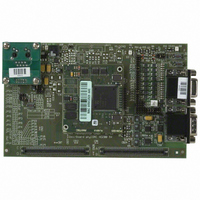EVAL-ADUC842QS Analog Devices Inc, EVAL-ADUC842QS Datasheet - Page 11

EVAL-ADUC842QS
Manufacturer Part Number
EVAL-ADUC842QS
Description
KIT DEV FOR ADUC842 QUICK START
Manufacturer
Analog Devices Inc
Series
QuickStart™ Kitr
Type
MCUr
Datasheet
1.EVAL-ADUC842QS.pdf
(88 pages)
Specifications of EVAL-ADUC842QS
Contents
Evaluation Board, Power Supply, Cable, Software and Documentation
Lead Free Status / RoHS Status
Contains lead / RoHS non-compliant
For Use With/related Products
ADuC842
Lead Free Status / RoHS Status
Not Compliant, Contains lead / RoHS non-compliant
TERMINOLOGY
ADC SPECIFICATIONS
Integral Nonlinearity
The maximum deviation of any code from a straight line
passing through the endpoints of the ADC transfer function.
The endpoints of the transfer function are zero scale, a point
½ LSB below the first code transition, and full scale, a point
½ LSB above the last code transition.
Differential Nonlinearity
The difference between the measured and the ideal 1 LSB
change between any two adjacent codes in the ADC.
Offset Error
The deviation of the first code transition (0000 . . . 000) to
(0000 . . . 001) from the ideal, i.e., +½ LSB.
Gain Error
The deviation of the last code transition from the ideal AIN
voltage (Full Scale – ½ LSB) after the offset error has been
adjusted out.
Signal-to-(Noise + Distortion) Ratio
The measured ratio of signal to (noise + distortion) at the
output of the ADC. The signal is the rms amplitude of the
fundamental. Noise is the rms sum of all nonfundamental
signals up to half the sampling frequency (f
The ratio depends on the number of quantization levels in the
digitization process; the more levels, the smaller the quantization
noise. The theoretical signal-to-(noise + distortion) ratio for an
ideal N-bit converter with a sine wave input is given by
Thus for a 12-bit converter, this is 74 dB.
Total Harmonic Distortion (THD)
The ratio of the rms sum of the harmonics to the fundamental.
Signal-to-(Noise + Distortion) = (6.02N + 1.76) dB
S
/2), excluding dc.
Rev. 0 | Page 11 of 88
DAC SPECIFICATIONS
Relative Accuracy
Relative accuracy or endpoint linearity is a measure of the
maximum deviation from a straight line passing through the
endpoints of the DAC transfer function. It is measured after
adjusting for zero error and full-scale error.
Voltage Output Settling Time
The amount of time it takes for the output to settle to a
specified level for a full-scale input change.
Digital-to-Analog Glitch Impulse
The amount of charge injected into the analog output when the
inputs change state. It is specified as the area of the glitch in nV-sec.
ADuC841/ADuC842/ADuC843




















